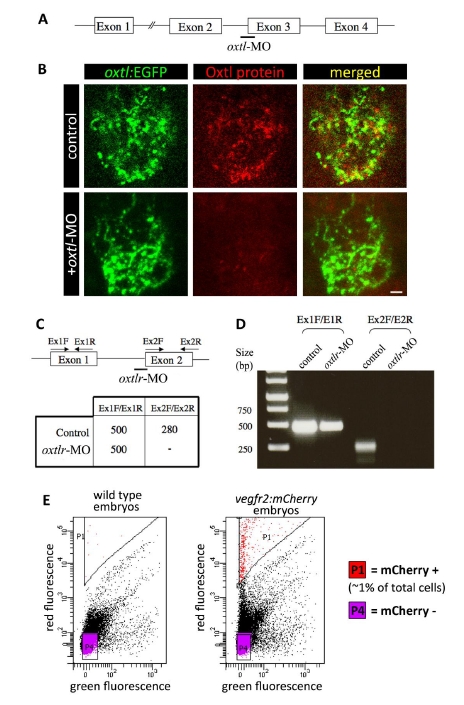Fig. S4
Figure S4 (related to Figure 6). Effects of oxtl and oxtlr gene knockdowns
A, Scheme depicting oxtl gene structure indicating the binding site of a splice blocking antisense oligonucleotide (oxtl-MO).
B, Reduction of Oxytocin (Oxtl) protein expression by oxtl-directed antisense oligonucleotide (oxtl-MO). Anti-oxytocin immunostaining of the neurohypophysis of 3-day old transgenic oxtl:EGFP embryos. Injection of oxtl-MO causes a marked reduction in Oxtl but not EGFP protein levels.
C, Scheme depicting oxtlr gene structure indicating the binding site of a splice blocking antisense oligonucleotide (oxtlr-MO) as well as the PCR primers used to amplify the respective exons (Ex) of the various mRNA products. A table summarizing the expected mRNA sizes in the control and followed oxtlr knockdown is shown at the bottom.
D, Gel electrophoresis analysis of PCR-amplified mRNA species in control and in embryos injected with oxtlr-MO. Primer pairs used to amplify the respective exons (Ex) are indicated at the top. Amplification of exon 1 (Ex1F/Ex1R) was used as control to demonstrate untargeted constitutive exon, which was not affected by the knockdown reagent.
E, Scatterplot representation of the fluorescence profiles of cell suspensions from dissociated 3-day old vegfr2:mCherry embryos (right) and their non-transgenic siblings (left), prior to FACS sorting. P1 is the proportion of cells that exhibit high red fluorescence (defined as ?mCherry+? cells, ~1% of the total population). P4 is the proportion of cells that exhibit no fluorescence (defined as ?mCherry-? cells, ~80% of the total population).
Reprinted from Developmental Cell, 21(4), Gutnick, A., Blechman, J., Kaslin, J., Herwig, L., Belting, H.G., Affolter, M., Bonkowsky, J.L., and Levkowitz, G., The hypothalamic neuropeptide oxytocin is required for formation of the neurovascular interface of the pituitary, 642-654, Copyright (2011) with permission from Elsevier. Full text @ Dev. Cell

